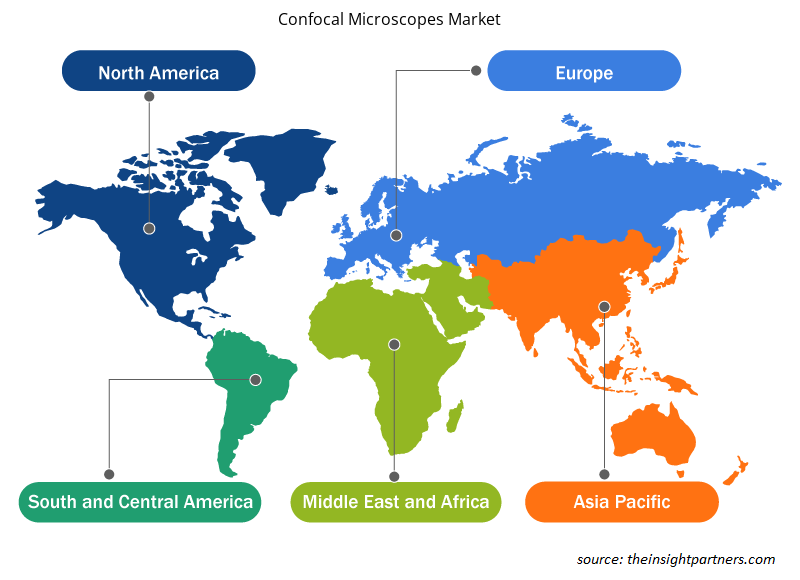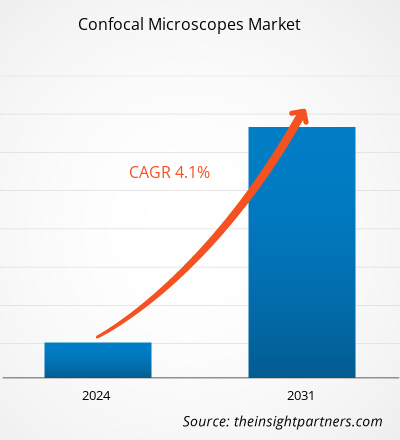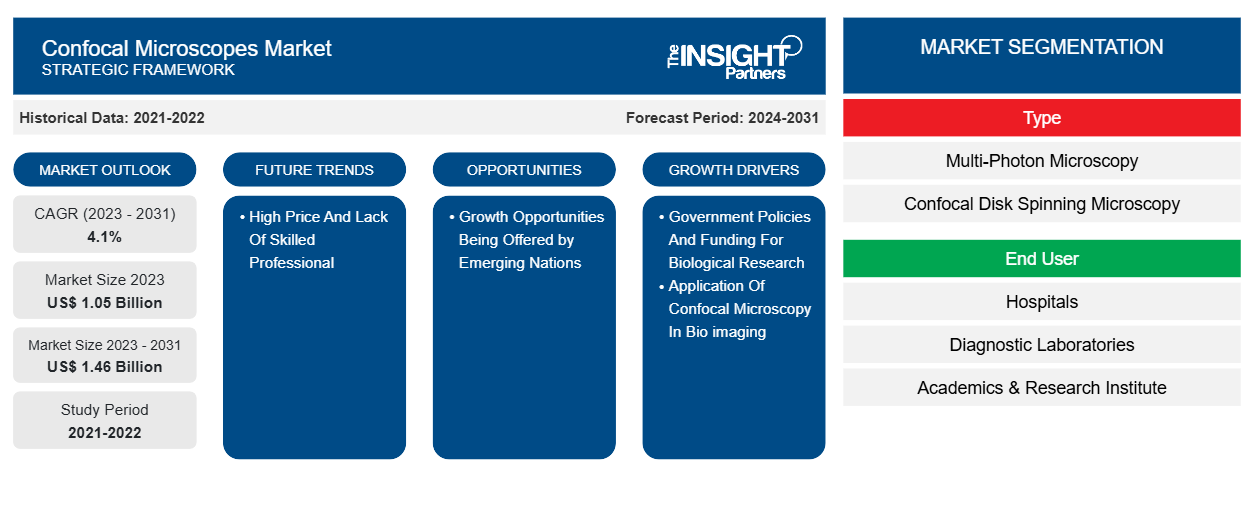Der Markt für konfokale Mikroskope soll von 1,05 Milliarden US-Dollar im Jahr 2023 auf 1,46 Milliarden US-Dollar im Jahr 2031 anwachsen. Der Markt wird zwischen 2023 und 2031 voraussichtlich eine durchschnittliche jährliche Wachstumsrate von 4,1 % verzeichnen. Die zunehmende Entwicklung fortschrittlicher Techniken und der Fokus der Akteure auf Schwellenländer werden voraussichtlich weiterhin wichtige Trends auf dem Markt bleiben.
Konfokale Mikroskope Marktanalyse
Konfokalmikroskope werden häufig verwendet, um die vollständige Struktur bestimmter Objekte innerhalb der Zelle deutlich darzustellen. Konfokale Bilder sind sehr wichtig und nützlich, um den Beitrag verschiedener Formen subnuklearer Strukturen zu identifizieren und die Kernsteifigkeit mehrerer Kerne auf globaler Ebene auf der Grundlage einfacher Kernisolationsprotokolle vorherzusagen. Die zunehmende Wirksamkeit der Mikroskope in den Biowissenschaften und der Biotechnologie zum Zweck der Zellstrukturforschung dürfte das Marktwachstum im Prognosezeitraum vorantreiben. Darüber hinaus treiben wachsende biologische Forschungsprojekte und entsprechende Finanzierungen, günstige Regierungsrichtlinien und eine breite Anzahl von Anwendungen der konfokalen Mikroskopie im Bereich der Biobildgebung den Markt an. Der hohe Preis und der Bedarf an qualifiziertem Personal für den Umgang mit konfokalen Mikroskopen könnten das Marktwachstum jedoch bremsen.
Marktübersicht für konfokale Mikroskope
Die konfokale Mikroskopie bietet gegenüber herkömmlichen Methoden mehrere Vorteile, darunter die Möglichkeit, die Schärfentiefe zu steuern, Hintergrunddetails aus der Brennebene zu entfernen oder zu reduzieren (was zu einer Bildverschlechterung führt) und serielle optische Schnitte von dicken Proben zu sammeln. Der wachsende Bedarf an konfokalen Mikroskopen ist auf die verschiedenen Forschungs- und Entwicklungsaktivitäten in mehreren Sektoren wie Neurowissenschaften, Materialwissenschaften und Biowissenschaften zurückzuführen. Tägliche Verbesserungen der Bildgebungstechnologien, wie z. B. verbesserte Empfindlichkeit und Auflösung sowie Bildgebungsgeschwindigkeiten, dürften ebenfalls die Akzeptanz konfokaler Mikroskope vorantreiben und so das Marktwachstum ankurbeln. Darüber hinaus suchen immer mehr Forscher nach hochmodernen Werkzeugen, die die Bildgebungsfunktionen verbessern würden, was wiederum Wachstumschancen für den Markt bieten würde.
Passen Sie diesen Bericht Ihren Anforderungen an
Sie erhalten kostenlos individuelle Anpassungen an jedem Bericht, einschließlich Teilen dieses Berichts oder einer Analyse auf Länderebene, eines Excel-Datenpakets sowie tolle Angebote und Rabatte für Start-ups und Universitäten.
-
Holen Sie sich die wichtigsten Markttrends aus diesem Bericht.Dieses KOSTENLOSE Beispiel umfasst eine Datenanalyse von Markttrends bis hin zu Schätzungen und Prognosen.
Markttreiber und Chancen für konfokale Mikroskope Microscopes Market Drivers and Opportunities
Anwendung der konfokalen Mikroskopie in der Biobildgebung zur Förderung des MarktesConfocal Microscopy In Bio imaging to Favor Market
Die konfokale Mikroskopie findet in der biologischen Forschung große Anwendung, beispielsweise bei microscopy is having huge application in the field of biology research like live der Bildgebung lebender Zellen , in neurowissenschaftlichen Studien und anderen Bereichen. Die konfokale Mikroskopie ermöglicht die Analyse von fluoreszenzmarkierten dicken Proben ohne physisches Schneiden, eine bessere Farbdifferenzierung ist möglich, da die Bilder auf dem System und nicht mit dem Auge betrachtet werden, eine dreidimensionale Rekonstruktion der Probe ist möglich und auch die Auflösung ist besser. Mithilfe einer konfokalen Mikroskopietechnik konnte das Forschungsteam eine Kaskade abnormaler Kapillarvasodynamik im Gehirn erkennen. Angesichts der enormen Anwendung der konfokalen Mikroskopie im Bereich der Biobildgebung ergreifen die Marktteilnehmer strategische Initiativen, um das Marktwachstum anzukurbeln.Confocal microscopy allows the analysis of fluorescent labelled thick specimens without physical sectioning, more color differentiation possible as images are viewed on the system rather than by eye, three-dimensional reconstruction of the specimen is possible also improved resolution. A confocal microscopy technique enabled the research team to detect a cascade of abnormal capillary vasodynamics in the brain. Considering the huge application of confocal microscopy in the field of bioimaging the market players are taking strategic initiatives for boosting the market growth.
Wachstumschancen in Schwellenländern
Die Gesundheitsbranche hat sich in den letzten Jahren rasant verändert. In Bereichen wie Fluoreszenzmikroskopie , Lasermikroskopen und dem Einsatz von 3D-Visualisierung bei Operationen wurden verschiedene technologische Fortschritte erzielt. Weitere Anwendungsmöglichkeiten des Konfokalmikroskops in der Dermatologie, bei histologischen Untersuchungen der Magen-Darm-Schleimhaut und bei der Bildgebung lebender Zellen zum Verständnis der Probe. Die Zunahme chronischer Erkrankungen wie Krebs und die Überalterung der Bevölkerung sind die Hauptfaktoren, die das Wachstum des Gesundheitssektors vorantreiben. Um bessere und fortschrittlichere Produkte und Technologien für die Gesundheitsbranche zu entwickeln, investieren verschiedene Akteure der Branche einen erheblichen Teil ihres Umsatzes in Forschungs- und Entwicklungsaktivitäten. Solche Faktoren bieten wahrscheinlich große Wachstumschancen für Konfokalmikroskope in der Gesundheitsbranche auf globaler Ebene.chaging rapidly over the past years. Various technological advancements have been witnessed in the segments such as, confocal microscope in the dermatology, gastrointestinal mucosal histology study, live cell imaging for understanding the specimen. The increase in incidences of chronic illnesses such as cancer and ageing population, are the primary factors fueling the growth of healthcare segment. For the development of better and advanced products and technologies for the healthcare industry various players in the industry are investing significant amount of their revenue in research and development activities. Such factors are likely to provide high growth opportunities for confocal microscopes in the healthcare industry at the global level.
Segmentierungsanalyse des Marktberichts für konfokale Mikroskope Microscopes Market Report Segmentation Analysis
Wichtige Segmente, die zur Ableitung der Marktanalyse für konfokale Mikroskope beigetragen haben, sind Typ und Endbenutzer.confocal microscopes market analysis are type and end user.
- Je nach Typ ist der Markt für konfokale Mikroskope in Multiphotonenmikroskopie und konfokale Disk-Spinning-Mikroskopie unterteilt. Das Segment der Multiphotonenmikroskopie hatte im Jahr 2023 den größten Marktanteil und wird im Prognosezeitraum voraussichtlich die höchste durchschnittliche jährliche Wachstumsrate verzeichnen.
- Nach Endverbraucher ist der Markt in Krankenhäuser, akademische und Forschungsinstitute sowie Diagnoselabore unterteilt. Das Segment der akademischen und Forschungsinstitute hatte 2023 den größten Marktanteil und wird voraussichtlich zwischen 2021 und 2031 die höchste durchschnittliche jährliche Wachstumsrate verzeichnen.
Konfokale Mikroskope Marktanteilsanalyse nach Geografie
Der geografische Umfang des Marktberichts für konfokale Mikroskope ist hauptsächlich in fünf Regionen unterteilt: Nordamerika, Asien-Pazifik, Europa, Naher Osten und Afrika sowie Süd- und Mittelamerika.
Nordamerika dominiert den Markt für konfokale Mikroskope. Faktoren, die zum Wachstum des Marktes für konfokale Mikroskope in Nordamerika führen, sind die steigende Zahl chronischer Erkrankungen und Augenleiden in der Region. Auch die Präzision, die konfokale Mikroskope bei der genauen Erkennung dieser Erkrankungen bieten, dürfte die Nachfrage im Prognosezeitraum ankurbeln. In den USA gibt es aufgrund verschiedener Faktoren wie unangemessener Lebensstandards, Urbanisierung sowie Drogenmissbrauch eine erhebliche Zahl chronischer Erkrankungen. Hautkrebs gehört in den USA zu den häufigsten Krebsarten. Daher dürften die Vorteile der konfokalen Mikroskopie bei der Krebserkennung zusammen mit der Unterstützung durch staatliche Stellen den Markt für konfokale Mikroskope in den kommenden Jahren ankurbeln.
Regionale Einblicke in den Markt für konfokale Mikroskope
Die regionalen Trends und Faktoren, die den Markt für konfokale Mikroskope im gesamten Prognosezeitraum beeinflussen, wurden von den Analysten von Insight Partners ausführlich erläutert. In diesem Abschnitt werden auch die Marktsegmente und die Geografie für konfokale Mikroskope in Nordamerika, Europa, im asiatisch-pazifischen Raum, im Nahen Osten und Afrika sowie in Süd- und Mittelamerika erörtert.

- Erhalten Sie regionale Daten zum Markt für konfokale Mikroskope
Umfang des Marktberichts zu konfokalen Mikroskopen
| Berichtsattribut | Details |
|---|---|
| Marktgröße im Jahr 2023 | 1,05 Milliarden US-Dollar |
| Marktgröße bis 2031 | 1,46 Milliarden US-Dollar |
| Globale CAGR (2023 - 2031) | 4,1 % |
| Historische Daten | 2021-2022 |
| Prognosezeitraum | 2024–2031 |
| Abgedeckte Segmente |
Nach Typ
|
| Abgedeckte Regionen und Länder |
Nordamerika
|
| Marktführer und wichtige Unternehmensprofile |
|
Marktteilnehmerdichte: Der Einfluss auf die Geschäftsdynamik
Der Markt für konfokale Mikroskope wächst rasant, angetrieben durch die steigende Nachfrage der Endnutzer aufgrund von Faktoren wie sich entwickelnden Verbraucherpräferenzen, technologischen Fortschritten und einem größeren Bewusstsein für die Vorteile des Produkts. Mit steigender Nachfrage erweitern Unternehmen ihr Angebot, entwickeln Innovationen, um die Bedürfnisse der Verbraucher zu erfüllen, und nutzen neue Trends, was das Marktwachstum weiter ankurbelt.
Die Marktteilnehmerdichte bezieht sich auf die Verteilung von Firmen oder Unternehmen, die in einem bestimmten Markt oder einer bestimmten Branche tätig sind. Sie gibt an, wie viele Wettbewerber (Marktteilnehmer) in einem bestimmten Marktraum im Verhältnis zu seiner Größe oder seinem gesamten Marktwert präsent sind.
Die wichtigsten auf dem Markt für konfokale Mikroskope tätigen Unternehmen sind:
- Olympus Corporation
- Leica Microsystems
- Nikon-Unternehmen
- Carl Zeiss AG
- Bruker
- KEYENCE CORPORATION
Haftungsausschluss : Die oben aufgeführten Unternehmen sind nicht in einer bestimmten Reihenfolge aufgeführt.

- Überblick über die wichtigsten Akteure auf dem Markt für konfokale Mikroskope
Marktnachrichten und aktuelle Entwicklungen zu konfokalen Mikroskopen
Der Markt für konfokale Mikroskope wird durch die Erhebung qualitativer und quantitativer Daten aus Primär- und Sekundärforschung bewertet, die wichtige Unternehmensveröffentlichungen, Verbandsdaten und Datenbanken umfasst. Nachfolgend sind einige der Entwicklungen auf dem Markt für konfokale Mikroskope aufgeführt:
- Leica Microsystems hat eine spannende neue Zusammenarbeit mit dem Department of Biochemistry der University of Oxford UK in den Bereichen optische und hochauflösende Mikroskopie, künstliche Intelligenz, korrelative Mikroskopie und EM-Probenpräparation angekündigt. Das Kompetenzzentrum wird von der erstklassigen Micron Bioimaging Facility des Department of Biochemistry der University of Oxford betrieben und wird hochmoderne Bildgebungslösungen von Leica Microsystems wie die konfokale Mikroskopplattform STELLARIS 5 und Mica Microhub beinhalten. (Leica Microsystems, News, September 2023)
- Nikon Instruments Inc. hat die Veröffentlichung des AX R MP mit NSPARC-Superauflösungs-Multiphotonen-Konfokalmikroskop angekündigt, das eine extrem empfindliche Array-Erkennung und Superauflösung in tiefen Bereichen innerhalb großer lebender Organismusproben ermöglicht. Dieses Produkt wird zum Verständnis von Hirnerkrankungen wie Alzheimer und Parkinson sowie zur Arzneimittelforschung beitragen. (Nikon Instruments Inc., News, Juli 2023)
- Discover Echo, ein BICO-Unternehmen und führender Anbieter innovativer Mikroskopie- und Bildgebungstechnologien, hat sein neuestes Produkt auf den Markt gebracht: das Echo Confocal-Mikroskop – ein fortschrittliches Bildgebungssystem, das hochauflösende Bilder biologischer Proben mit außergewöhnlicher Klarheit und Detailtreue liefert. Dieses Produkt öffnet Discover Echo die Tür zu einem brandneuen globalen Markt, da das Echo Confocal eine beispiellose Benutzerfreundlichkeit und Zugänglichkeit bietet. Das Echo Confocal-Mikroskop ist auf Benutzerfreundlichkeit ausgelegt und verfügt über eine Reihe automatisierter Funktionen zur Vereinfachung der Bilderfassung. Seine einzigartige intuitive Benutzeroberfläche erleichtert Forschern aller Erfahrungsstufen die Bedienung, während sein kompaktes Design es ermöglicht, es problemlos in jede Laborumgebung zu integrieren. (BICO, Pressemitteilung, Februar 2023)
- Nikon Instruments Inc. hat den Nikon Spatial Array Confocal (NSPARC)-Detektor für AX-Systeme angekündigt. Das neu entwickelte konfokale Detektorsystem verwendet ein Detektorarray mit extrem geringem Rauschen für die punktweise abtastende konfokale Datenerfassung, wodurch das Signal-Rausch-Verhältnis verbessert wird und so eine Bildgebung bei geringerer Anregungsleistung möglich wird. Dies ermöglicht eine hochauflösende Bildgebung von lebendem Gewebe bei minimaler Phototoxizität. Die Markteinführung dieses Produkts ist für Anfang Februar 2023 geplant und wird in Kombination mit konfokalen AX- oder AX R-Mikroskopen verwendet. (Nikon Instruments Inc., News, Februar 2023)
Marktbericht zu konfokalen Mikroskopen – Umfang und Ergebnisse
Der Bericht „Marktgröße und Prognose für konfokale Mikroskope (2021–2031)“ bietet eine detaillierte Analyse des Marktes, die die folgenden Bereiche abdeckt:
- Marktgröße und Prognose für konfokale Mikroskope auf globaler, regionaler und Länderebene für alle wichtigen Marktsegmente, die im Rahmen des Projekts abgedeckt sind
- Markttrends für konfokale Mikroskope sowie Marktdynamik wie Treiber, Einschränkungen und wichtige Chancen
- Detaillierte PEST- und SWOT-Analyse
- Marktanalyse für konfokale Mikroskope mit wichtigen Markttrends, globalen und regionalen Rahmenbedingungen, wichtigen Akteuren, Vorschriften und aktuellen Marktentwicklungen
- Branchenlandschaft und Wettbewerbsanalyse, einschließlich Marktkonzentration, Heatmap-Analyse, prominenten Akteuren und aktuellen Entwicklungen auf dem Markt für konfokale Mikroskope
- Detaillierte Firmenprofile
- Historische Analyse (2 Jahre), Basisjahr, Prognose (7 Jahre) mit CAGR
- PEST- und SWOT-Analyse
- Marktgröße Wert/Volumen – Global, Regional, Land
- Branchen- und Wettbewerbslandschaft
- Excel-Datensatz
Aktuelle Berichte
Verwandte Berichte
Erfahrungsberichte
Grund zum Kauf
- Fundierte Entscheidungsfindung
- Marktdynamik verstehen
- Wettbewerbsanalyse
- Kundeneinblicke
- Marktprognosen
- Risikominimierung
- Strategische Planung
- Investitionsbegründung
- Identifizierung neuer Märkte
- Verbesserung von Marketingstrategien
- Steigerung der Betriebseffizienz
- Anpassung an regulatorische Trends























 Kostenlose Probe anfordern für - Markt für konfokale Mikroskope
Kostenlose Probe anfordern für - Markt für konfokale Mikroskope